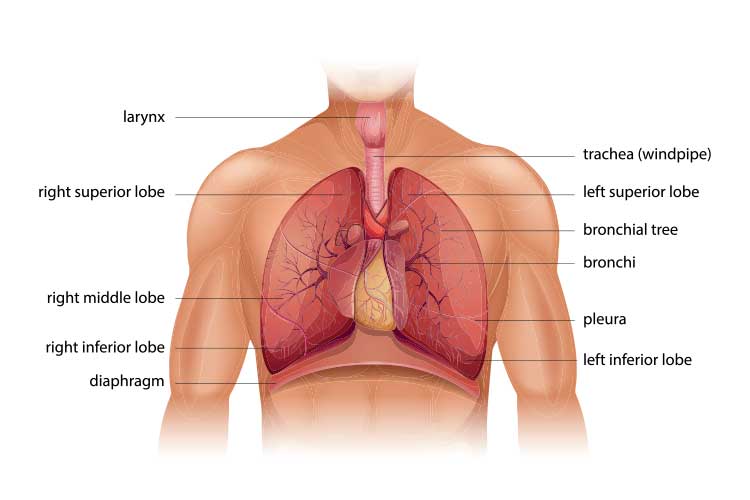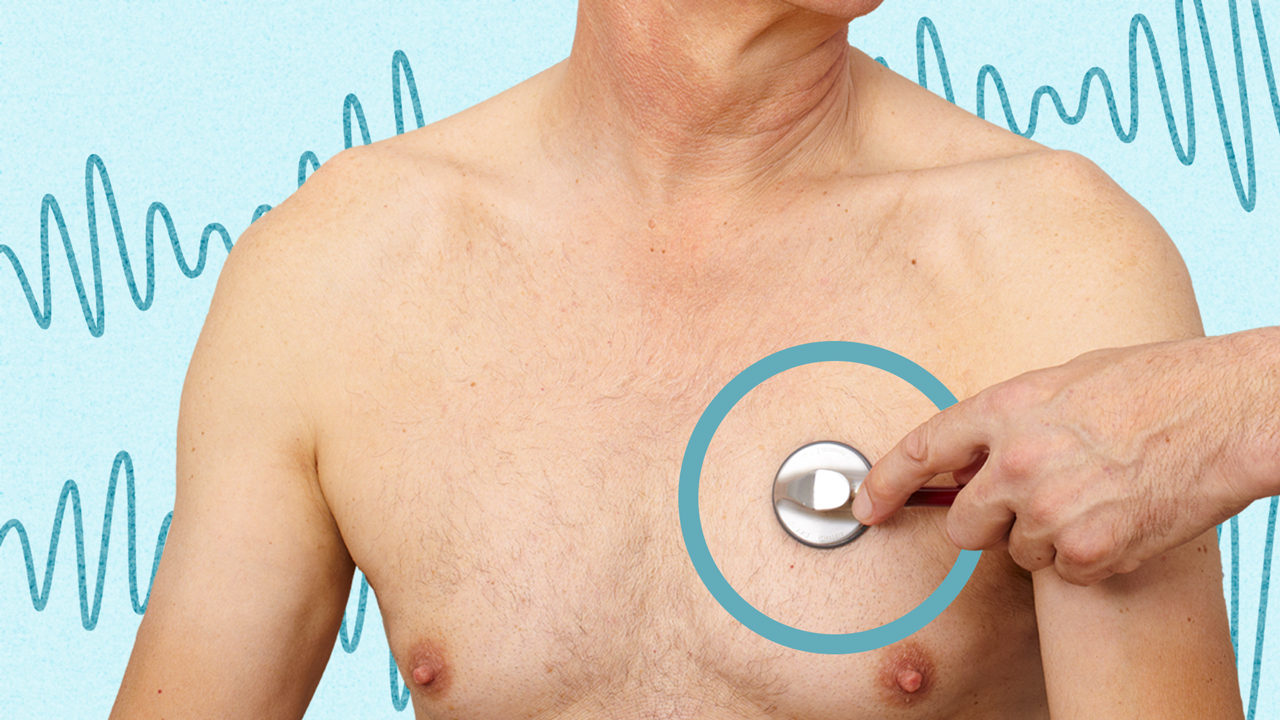Chest auscultation is a straightforward but highly useful diagnostic technique that dates back to over 2,000 years ago.
What is Chest Auscultation?
Chest auscultation involves using a stethoscope to listen to a patient’s respiratory system and interpreting the lung sounds heard (Physiopedia 2023).
Auscultation is a fundamental component of physical examination that can assist in the diagnosis of respiratory issues. It is a non-invasive, safe procedure dating back to the era of Hippocrates (who used his ear rather than a stethoscope), making it one of the oldest diagnostic techniques (Physiopedia 2023; Proctor & Rickards 2020).
In addition to the respiratory system, auscultation can also be used to examine the heart, circulatory system and gastrointestinal system (Physiopedia 2024).
Despite being a fairly straightforward assessment, chest auscultation is a skill that requires considerable practice and understanding of the respiratory system so that you can differentiate normal respiratory sounds from abnormal and adventitious sounds (e.g. sibilant wheezes and crackles), to accurately diagnose patients (Physiopedia 2023).
The more lung sounds you listen to, the easier it will be to identify an abnormality and report it to a member of the medical team.
It is important to remember that auscultation is just one component of respiratory assessment; ensure you also monitor the rise and fall of the patient’s chest and identify any potential difficulties they may be experiencing (shallow breathing, pain, use of accessory muscles, reduced ability to follow instructions, sputum production, asymmetry of the chest etc.).
Chest auscultation should be contextualised to a patient’s medical history and form one component of a holistic assessment (Proctor & Rickards 2020).
What are Lung Sounds?
Lung sounds are caused by vibrations of the vocal cords during inspiration and expiration, which are transmitted to the trachea and bronchi. These sounds can be used to monitor airflow through the trachea and bronchial tree (Proctor & Rickards 2020).

Causes of Abnormal Lung Sounds
Common causes of abnormal lung sounds include:
- Bronchitis
- Asthma
- Heart failure
- Pneumonia
- COVID-19
- Chronic obstructive pulmonary disease (COPD)
- Foreign body.
(Kahn 2022)
When Should Chest Auscultation be Performed?
Ideally, chest auscultation should be performed on all patients as part of a head-to-toe assessment. This will ensure you have adequate insight into a patient’s condition at the commencement of your shift or upon admission to hospital or a care facility, and you will be able to escalate care if any deterioration is identified.
Other situations where chest auscultation may be used include:
- Patient deterioration (or early detection of deterioration)
- Respiratory conditions
- Cardiac conditions
- Heart failure
- Perioperative examination.
(Pirrotta et al. 2021; Shams et al. 2025; Open RN 2023; Sampsonas et al. 2023)
How to Perform Chest Auscultation

- Prepare a quiet environment so that you will be able to clearly hear the patient’s lung sounds.
- Ensure the patient is haemodynamically stable before mobilising them.
- Ensure the patient’s pain (if any) has been adequately treated. Consider analgesia if needed.
- Ensure all lines and drains are positioned safely when mobilising the patient.
- Sit the patient in a chair or upright on the side of the bed if possible.
- Consider PPE precautions if required (always follow your organisation’s policies and procedures).
- Ensure you have a clean, designated stethoscope for the patient.
- The assessment requires the patient’s chest and back to be exposed - ensure the patient’s privacy and dignity are maintained.
- Using gentle pressure, place the diaphragm (chest piece) of the stethoscope flat on the patient’s chest.
- Listen to lung sounds on the anterior chest using the ‘stepladder’ pattern. At each point, you should ensure the diaphragm stays in contact with the chest for one full inspiration and expiration cycle.
- Repeat this process for the posterior chest (avoiding the scapula).
- Listen to the patient’s right lateral chest (they will need to move their right arm out of the way). Listen to the upper lobe, then the middle lobe, then the lower lobe.
- Repeat this process for the left lateral chest (there is an upper and lower lobe only).
(Proctor & Rickards 2020)
Differentiating Lung Sounds
Read: Important Lung Sounds Made Easy: A Practical Guide (With Full Audio)
Complications
- If the patient becomes dizzy, call for help. Put the patient back into bed immediately or lower them onto the floor safely.
- If the patient’s intravenous or central line dislodges due to mobilisation, call for assistance.
- If the patient becomes haemodynamically unstable, place them in a safe position on the bed or floor, adhering to safe manual handling practices.
If the patient experiences sudden or severe difficulty breathing or stops breathing, this is an emergency. Perform a respiratory assessment and commence basic life support if required.
Conclusion
Chest auscultation is an important component of respiratory assessment. By having a baseline of the patient’s condition, you should be able to recognise any early signs of deterioration.
Ensure you familiarise yourself with lung sounds, as the more you practice, the better you will become at identifying abnormalities.
Test Your Knowledge
Question 1 of 3
True or false: Chest auscultation should be performed on all patients.
Topics
Further your knowledge
 Free
Free Free
Free Free
FreeReferences
- Kahn, A 2022, ‘Breath Sounds’, Healthline, 18 October, viewed 30 May 2025, https://www.healthline.com/health/breath-sounds
- Open RN 2023, ‘Chapter 10 Respiratory Assessment’, in Ernstmeyer K & Christman E (eds.), Nursing Skills, 2d edn, Chippewa Valley Technical College, Eau Claire, viewed 3 June 2025, https://www.ncbi.nlm.nih.gov/books/NBK596716/
- Physiopedia 2023, Lung Sounds, Physiopedia, viewed 30 May 2025, https://www.physio-pedia.com/Lung_Sounds
- Physiopedia 2024, Auscultation, Physiopedia, viewed 30 May 2025, https://www.physio-pedia.com/Auscultation
- Pirrotta, F, Mazza, B, Gennari, L & Palazzuoli, A 2021, ‘Pulmonary Congestion Assessment in Heart Failure: Traditional and New Tools’, Diagnostics, vol. 11, no. 8, viewed 3 June 2025, https://pmc.ncbi.nlm.nih.gov/articles/PMC8394474/
- Proctor, J & Rickards, E 2020, ‘How to Perform Chest Auscultation and Interpret the Findings’, Nursing Times, 6 January, viewed 3 June 2025, https://www.nursingtimes.net/clinical-archive/assessment-skills/how-to-perform-chest-auscultation-and-interpret-the-findings-06-01-2020/
- Sampsonas, F, Antonogiannaki, M, Vittorakis, S et al. 2023, ‘Preoperative Evaluation of the Respiratory System: A Narrative Review Based on Hellenic Thoracic Society Guidelines’, Pneumon, vol. 36, no. 3, viewed 3 June 2025, https://www.pneumon.org/Preoperative-evaluation-of-the-respiratory-system-A-narrative-review-based-on-Hellenic,163183,0,2.html
- Shams, P, Malik, A & Chhabra, L 2025, ‘Heart Failure (Congestive Heart Failure)’, StatPearls, viewed 3 June 2025, https://www.ncbi.nlm.nih.gov/books/NBK430873/
 New
New 
